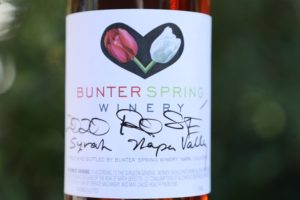
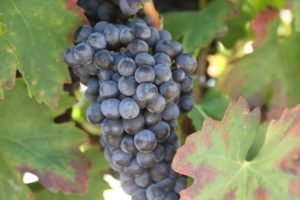
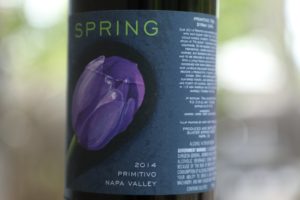 Bunter Spring Winery is a small winery located just east of the Napa city limits. Founder Mark Bunter grew up in the south part of Napa Valley; his father purchased three acres in 1974 in what is now the Coombsville appellation although they did not plant grapes on site until many years later. Mark’s introduction to wine began at Tulocay Winery, a small neighboring winery that was founded by Bill Cadman in 1974. Mark started working there only three years later in 1977 while still in high school, helping Bill with his small bottling line. Tulocay Winery continues to produce limited production wines, now overseen by Bill’s daughter Brie.
Bunter Spring Winery is a small winery located just east of the Napa city limits. Founder Mark Bunter grew up in the south part of Napa Valley; his father purchased three acres in 1974 in what is now the Coombsville appellation although they did not plant grapes on site until many years later. Mark’s introduction to wine began at Tulocay Winery, a small neighboring winery that was founded by Bill Cadman in 1974. Mark started working there only three years later in 1977 while still in high school, helping Bill with his small bottling line. Tulocay Winery continues to produce limited production wines, now overseen by Bill’s daughter Brie.
This introduction to the wine world, and as Mark says, “many bottles of Pinot Noir later” perked his interest in wine making. He went on to earn two A.S. degrees at Napa College in both Viticulture and Winemaking while also taking wine making extension courses. Over the years he has worked at several prominent Napa wineries including at Charles Krug, Robert Mondavi and St. Supery where he was assistant winemaker.
Mark never thought about making his own wine until a friend convinced him to do so. In 1991 he made his first home wine, crafting small lots from second crop grapes. The next year he started planting Syrah grapes on his family’s property; he recalls hand digging every hole for every grape vine with a pry bar. Ultimately, he was able to plant 1/2 an acre of Syrah. His father Arnie managed these vines for many years until they were eventually removed. The last vintage of Bunter Spring Syrah was in 2021.
After accompanying his wife Margaret to Virginia (where she took a job with the government), Mark became winemaker at Chrysalis Vineyards in Virginia, one of the top producers of the native American grape Norton.
Eventually Mark moved back to California – and in 2008 bonded the ‘garage’ on their property in Coombsville as a working winery.
The winery takes its name from combining Mark’s last name and Margaret’s maiden name.
Any wines made organic and legally labeled as such (per the current USDA Organic Standards) must be under 10 ppm sulfites; these are wines that have no added sulfites – the only sulfites contained are naturally occurring. Any wines that Mark makes organic are bottled under Bünter Natur, identified by his family crest on the label. This includes the estate Coombsville Syrah, and a Pinot Noir sourced from the Santa Cruz Mountains. And with total transparency, the Bunter Springs bottlings list on their labels, the total sulfites added to the wines.
The rest of their wines are bottled under the Spring label using an image of a tulip on each bottle. During harvest Mark is especially busy dividing his time between Monterey County and his winery in Coombsville. He makes all the Napa grown wines in Coombsville and produces his non-Napa wines at a winery near his home.
Mark sources premium grapes from select vineyards from the north to the south part of Napa Valley including from a special vineyard that has both pedigree in ownership and vines, the Muir Hannah Vineyard. This particular vineyard is located in the Oak Knoll District and is owned by the direct descendants of naturalist John Muir. In addition, this vineyard provided much of the Chardonnay for Chateau Montelena’s 1973 winning wine at the Paris Tasting of 1976.
Mark creates wines as simply and as naturally as possible – often using indigenous yeasts, bottling unfined and often unfiltered and using moderate amounts of sulfur dioxide (SO2) or in the case of his organic wines, no added sulfites. As a result the wines are all distinctive with their own personalities. No cookie cutter production here. His father’s vineyard was organically farmed; Mark also tries to work with growers who farm organically or biodynamically.
He also strongly believes in transparency and letting the consumer know what has been put into each bottle of wine. As a result, his labels include an “ingredient” listing including sometimes very specific details about the winemaking process as it relates to a particular wine. He prefers wines that are under 14% alcohol and often creates wines that are lower alcohol (especially for Napa standards). His Napa Valley wines generally do not taste like the contemporary style of wines being produced in the valley today.
A ‘large’ production for Bunter Spring would be 100 cases; all the wines are produced as very small lots often in the 50-case range.
While there are many Napa vineyards that are farmed organically, out of more than 1,150 Napa wineries and producers visited and reviewed on this site to date, we have come across extremely few Napa Valley wines that are made organically (no sulfites added). The ones we have tasted were generally produced by winemakers wanting to experiment with making an organic wine and were not bottled for commercial release.
Select Wines
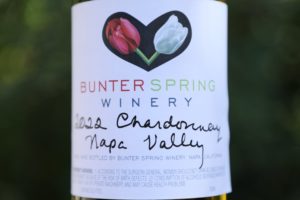
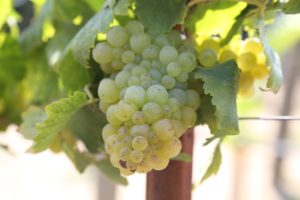 The 2022 Bunter Spring Chardonnay, Coombsville Napa Valley is medium yellow; the attractive bouquet offers aromas of honeysuckle, red apple, pear, yellow nectarine, pineapple, cantaloupe, and passion fruit. Built in a lighter style, this wine is balanced and brightly shines across the palate. It reveals flavors of quince, apples and pear with a touch of stone fruits. Minerally with a supple, rounded and creamy-like texture. Did we already say balanced? If so we will say it again. Easy drinking. While tasting this wine we thought it might pair well with freshly grilled wild prawns. It residual sugar is 2.8 g/l; most people start noticing a little sweetness around 0.8 g/L. The sweetness here is lightly felt, showing primarily on the finish. It was barrel fermented with a judicious use of oak; this wine is clearly about the fruit rather than barrel influences. And it is a refreshing alcohol as well: 12.93%.
The 2022 Bunter Spring Chardonnay, Coombsville Napa Valley is medium yellow; the attractive bouquet offers aromas of honeysuckle, red apple, pear, yellow nectarine, pineapple, cantaloupe, and passion fruit. Built in a lighter style, this wine is balanced and brightly shines across the palate. It reveals flavors of quince, apples and pear with a touch of stone fruits. Minerally with a supple, rounded and creamy-like texture. Did we already say balanced? If so we will say it again. Easy drinking. While tasting this wine we thought it might pair well with freshly grilled wild prawns. It residual sugar is 2.8 g/l; most people start noticing a little sweetness around 0.8 g/L. The sweetness here is lightly felt, showing primarily on the finish. It was barrel fermented with a judicious use of oak; this wine is clearly about the fruit rather than barrel influences. And it is a refreshing alcohol as well: 12.93%.
The 2022 Bunter Spring White Wine, Dorciel Vineyard Santa Clara County is deep straw in the glass; the bouquet is initially quite shy and needs a serious amount of time in the glass for the aromatics to be coaxed out. It took about 45 minutes for the bouquet to fully open. We taste through Napa Valley Sauvignon Blanc on a weekly basis; this wine smells nothing like the varietal characteristics we have come to know, either from a early harvested more grassy showing or a later harvest, ripe more and ‘tropical’ showing. Therefore if we were to place this wine in a blind tasting of Napa Valley Sauvignon Blancs from the same vintage, this bottling would clearly stand out. It sports aromas of dried straw, fennel, lemon zest and a light note of lemongrass. The palate is bright and lively with flavors of dried oyster shells, pomelo, passion fruit and lime. The finish is mouthwatering, featuring balanced by not bracing acidity and is accompanied by a velvet-like and gentle rounded texture. This wine would pair well with Gulf Prawns – reminding of the prawns we have purchased several times from the side of a boat docked at Moss Landing, CA.
The 2022 Butner Spring Macerated White, Santa Clara County is medium gold in color. This extremely limited and unusual production wine (12 cases) was crafted from the same Sauvignon Blanc grapes as was used to make the Bunter Spring White Wine, also in 2022. The difference being that this wine was fermented on the skins for ten days before being pressed. The exotic and distinctive bouquet is remarkably different, and more pronounced in its aromatic profile as compared to the Sauvignon Blanc produced with no skins during fermentation. Discard most normal Sauvignon Blanc descriptors. It reveals scents of brined apples (a Russian favorite spanning centuries), honeycomb, ripe pineapple, a hint of juniper berry and damp straw. The minerally palate offers a salinity that is best described as savory. There are flavors of lemon, not fully ripe Crenshaw melon, guava on the greener side of its ripeness spectrum, young pine needles (we are not in a habit of eating these, but we have tried them before) and an herbal note similar to lemongrass. Only 11.8% alcohol.
The 2020 Bunter Spring Rosé of Syrah, Napa Valley Estate is medium garnet in color, for a rose, this wine is not lacking in terms of color. The bouquet offers a diversity of distinctive aromatics including a briny or saline character, dried orange peel, strawberries, watermelon, dried rose petals, blooming citrus trees and pineapple guava blossom. Balanced with a soft textural feel from the entry through to the finish, this wine sports flavors of rhubarb, raspberry, wild strawberries, blood orange, pomegranate, Rainier cherry and a very subtle hint of dill on the finish. Drinks well by itself but it should be able to hold up with a variety of seafood dishes including halibut. This wine was not fined or filtered before bottling and for reference, we tasted this about 4 years post vintage.
Every vintage of the Bunter Spring Syrah is made as an organic wine; the first vintage of this wine was in 2009. The 2013 Bünter “natur” Coombsville Estate Syrah initially shows an earthiness including notes of mushroom which reveals more fruit as the wine opens in the glass. Also, savory on the bouquet and somewhat floral. Very supple and smooth on the palate with just a kiss of tannins lingering delicately along with a red fruit tartness and a hint of pepper. Not a big spicy high alcohol Syrah. Drinks very well young. Continues to evolve nicely in the glass over time and can hold up to being open for a day or two. Very grill friendly!
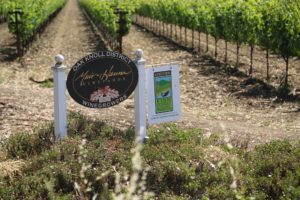 The 2014 Bunter Spring Primitivo is 76% Primitivo and 24% Syrah. This wine was picked at a higher brix and fermented using indigenous yeast which stopped their fermentation when the wine was at 7% sugar. At that point, a pied de cuvee of actively fermented lower sugar Syrah was added ultimately completing the fermentation. But a resulting higher acetic acid required reverse osmosis. It was then aged in 1/3 new American oak barrels and 2/3 used French oak barrels. Only 30 ppm sulfites were added prior to bottling.
The 2014 Bunter Spring Primitivo is 76% Primitivo and 24% Syrah. This wine was picked at a higher brix and fermented using indigenous yeast which stopped their fermentation when the wine was at 7% sugar. At that point, a pied de cuvee of actively fermented lower sugar Syrah was added ultimately completing the fermentation. But a resulting higher acetic acid required reverse osmosis. It was then aged in 1/3 new American oak barrels and 2/3 used French oak barrels. Only 30 ppm sulfites were added prior to bottling.
This wine is medium to deep ruby in color; when we first tasted this wine, the layered bouquet offered plenty of bright, mostly red-fruited berry aromas with a note of wintergreen. We have since tasted this wine 10 years post vintage and the bouquet has become more character driven and has evolved dramatically. It offers scents of leather, dried mushrooms, damp potting soil, a meatiness, farmyard, dried tobacco and dried herbs. On the palate there is sweet and sour and tangy note that most likely is the result of the original higher acetic acid. This wasn’t as prominent when we first tried the wine a few years post vintage. The palate offers flavors of tart cherry, currant and cranberry with a lingering note of tobacco spice. The image of the purple tulip on the label was painted by Portland, ME based artist Mary Hart. 14.70% alcohol.
The 2012 Bunter Spring Red Wine Napa Valley “Garagitage” reveals pretty aromas including fig notes and dessert spices. Ripe with a firm structure, it is not out of balance. Cherry, cranberry, and currants. Excellent acidity – with both a lingering tartness and fairly robust somewhat drying tannins on the finish.
Former Tasting Room, Carmel Valley Village
In 2015 Mark opened a tiny tasting room in Carmel Valley Village located about three hours southwest of the city of Napa. NOTE: Mark permanently closed this tasting room on July 1, 2022, but we keep our notes and photographs here for historical reference. Carmel Valley Village is home to some 25+ tasting rooms, many of which are easily within walking distance of each other. Mark had no staff and kept his hours somewhat limited open Friday-Sunday from 1-6pm each day or by appointment. In a world of tasting rooms where you don’t often meet the owner or winemaker, it is refreshing to talk directly with the person making the wines. Mark is a wealth of information especially about the technical aspects of wine making.
And equally refreshing are Mark’s prices – maintaining a very reasonable price to quality ratio, even for his Napa wines which have inherent higher costs then wines from other parts of California.
Mark does not distribute his wines or sells online – rather most of his sales are direct to consumer including a wine club, in addition to select placements in parts of the San Francisco Bay area including Terroir Natural Wine Merchant in San Francisco and at Ad Hoc in Yountville and sometimes the Napa General Store in the city of Napa. For more information or to purchase wine, please visit: www.bunterspringwinery.com






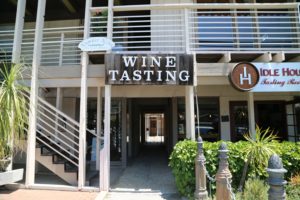

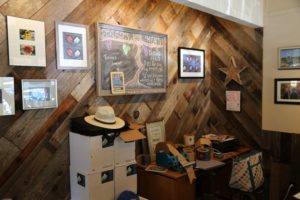
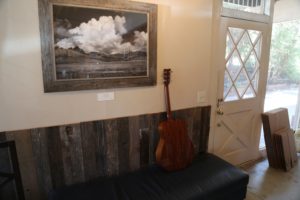
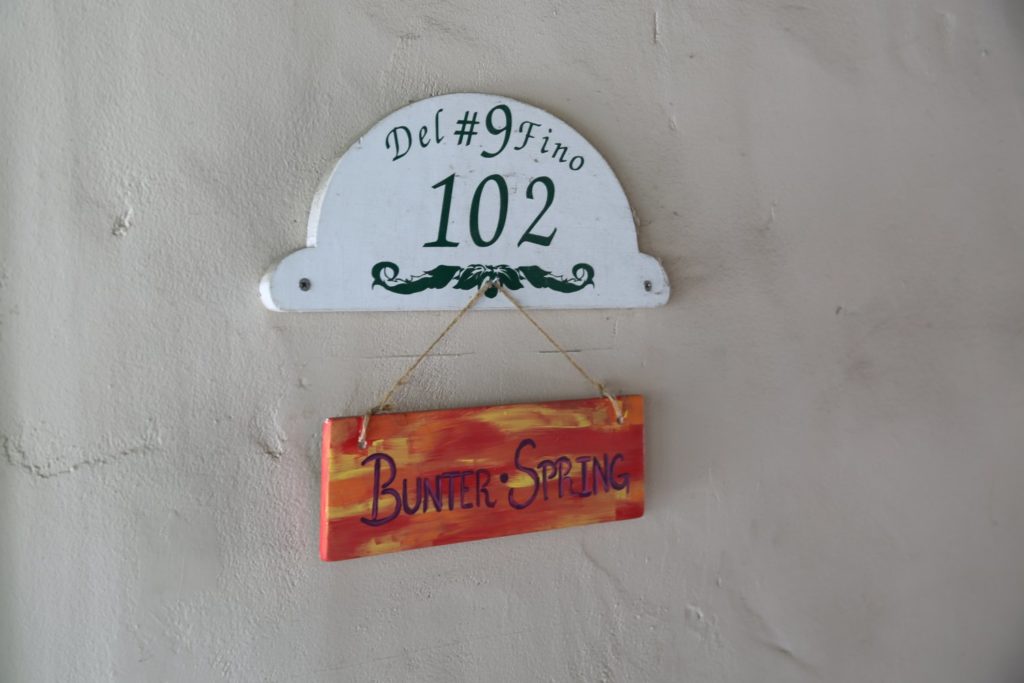
Wonderful to see such a nice review on a small vineyard. Would love to take visit to that area.
We’d love to have you come to our bustling village- it’s quite the scene these days!